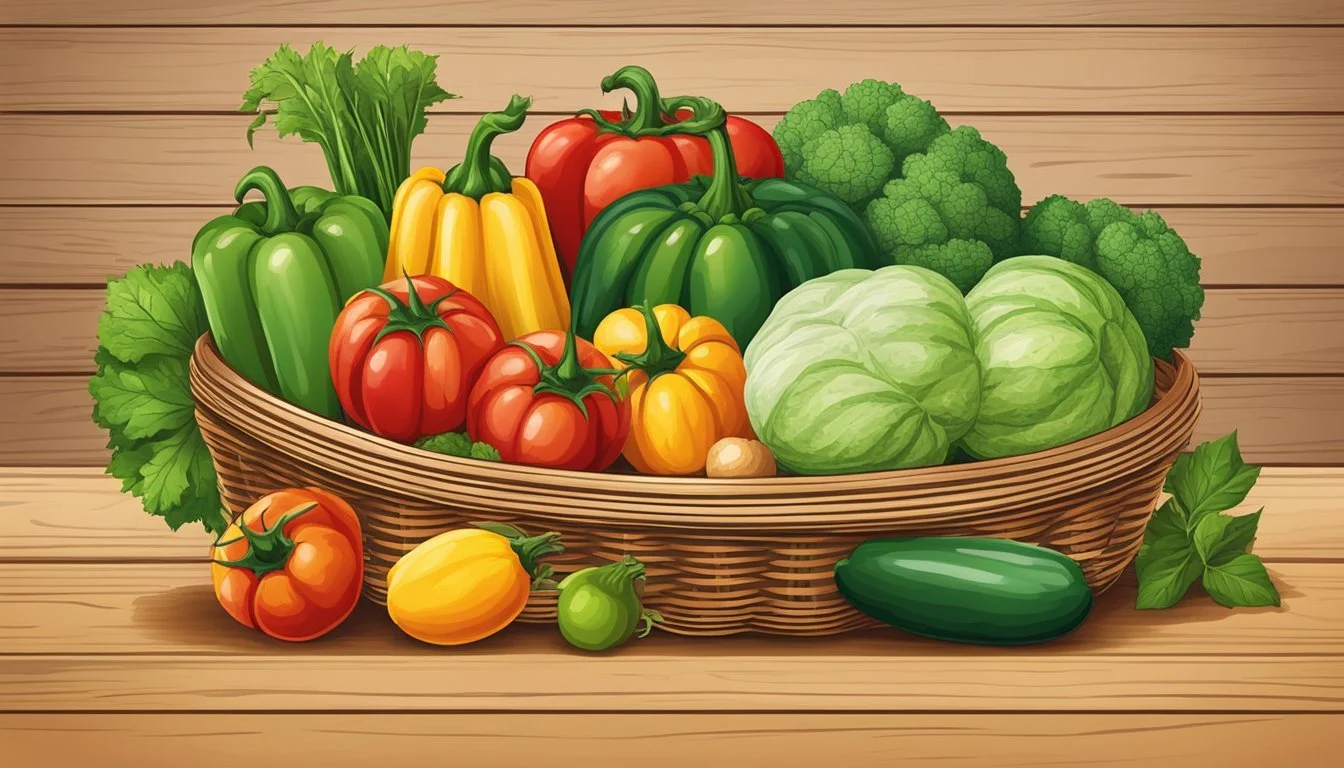Georgia Seasonal Fruit & Vegetables in June
Your Guide to Fresh Picks
This Article is Part of our Georgia Seasonal Fruit & Veg Calendar
June in Georgia brings a bounty of fresh produce, marking a period when the state’s farms and local markets are abundant with a variety of fruits and vegetables at the peak of their flavor. During this month, Georgia's warm climate fosters the growth of a spectrum of seasonal offerings. Consumers can enjoy the benefits of both taste and nutrition from produce that has been harvested at just the right time for consumption. Shopping for seasonal produce not only supports local agriculture but also promises fresher, more flavorful ingredients for summer meals.
Among the fruits that come into season, Georgia is particularly noted for its succulent peaches, which become ripe and ready to enjoy in June. Blueberries (how long do blueberries last?), another Georgia staple, also hit their stride during this period, offering up their sweet and tangy flavors. These fruits, along with others like plums and blackberries (how long do blackberries last?), can be found fresh in local markets and are ideal for a range of culinary uses from homemade preserves to refreshing salads.
The vegetable selection is equally robust, with tender varieties such as cucumbers (how long do cucumbers last?), eggplants (What wine goes well with eggplant?), and green beans coming into harvest. Fresh greens like collard greens (how long do collard greens last?) and chard are still available, extending their seasonality from earlier months. Corn, a summer favorite for many, begins to reach maturity, perfect for grilling or enjoying as sweet corn on the cob. These vegetables are not only versatile in the kitchen but also packed with nutrients, making them a healthy addition to any dish.
Understanding Georgia's Growing Seasons
The transition from spring to summer in Georgia marks a significant period in the state's agricultural calendar. During this time, a variety of fruits and vegetables begin to reach their peak ripeness, benefitting from the region's climatic conditions.
Spring to Summer Transition
In Georgia, the growing season transitions smoothly from spring to summer, providing a rich and diverse agricultural output. Spring crops are often still available early in June, while summer varieties start to become prominent. This overlap ensures a continuous supply of fresh produce. Farmers carefully plan crop rotations and planting schedules to maximize yield and take advantage of the warm weather that characterizes Georgia's late spring and early summer months.
June's Climatic Conditions
By June, Georgia typically experiences warm, humid weather, which is conducive to growing a wide range of produce. Average temperatures range from 64°F to 89°F, creating ideal conditions for summer crops to flourish. It's crucial for farmers to monitor weather patterns during this period as proper irrigation and pest control become paramount to safeguard against the intense heat and potential dry spells. This growing season is characterized by long, sunny days that contribute to the sweetness and quality of the fruits and particularly the famed Georgia peaches.
June Harvest in Georgia
June in Georgia marks the transition from spring to summer, bringing a diverse bounty of fruits and vegetables to the table. During this time, farmers and gardeners reap the benefits of the warm weather, which initiates the harvest of several early summer crops and ushers in the peak time for midsummer produce.
Early Summer Harvest
June introduces a variety of fruits and vegetables that signal the beginning of summer's abundance. Notable early summer crops include:
Squash: Both yellow and zucchini varieties are abundant.
Cucumbers: Known for their cool, refreshing taste and versatility in salads.
Green Beans: These are often picked at their tender, crisp stage.
Peaches: Georgia is famous for its sweet, juicy peaches, with June being a prime harvest month.
Blueberries: A jewel among fruits, Georgia blueberries start to peak in early June.
These early risers are often found at local markets and provide a fresh taste of the season.
Midsummer Crop Availability
As June progresses, the full flush of summer hits its stride with a wider availability of crops:
Tomatoes: Ripe, full-flavored tomatoes begin to make their appearance.
Corn: Sweet corn is a staple of Georgian summers, perfect for cookouts.
Eggplant (What wine goes well with eggplant?): Starting to come into season, adding a variety of options for dishes.
Blackberries and Raspberries: Berries continue to flourish, with these becoming ready for harvest.
This period is significant for the agricultural calendar as it sets the stage for the plentiful summer harvests that follow.
Fruits Available in June
June in Georgia is a bountiful month for fruit lovers, with a variety of fresh, juicy fruits ripening under the warm Southern sun. This time of year is particularly known for the sweet and succulent stone fruits, an array of nutrient-packed berries, and the refreshing crunch of ripe melons.
Stone Fruits
In June, Georgia's orchards offer a diverse range of stone fruits. Peaches, the state's iconic fruit, are especially abundant and known for their distinctly sweet flavor and velvety skin. The variety of peaches can include the Elberta and Georgia Belle. Plums are also in season, with their smooth skin and sweet flesh that ranges from juicy to firm.
Berries
The berry harvest is in full swing during the month of June. Blueberries, both highbush and rabbiteye varieties, are commonly harvested. Their deep blue hue and sweet-tart flavor make them a popular choice for both fresh eating and culinary use. Blackberries are also ripe for picking, bursting with flavors that are both tart and sweet.
Melons
As the Georgia heat intensifies, melons begin to come into their peak season. Watermelons with their thick green rinds and vibrant red, sweet flesh become a staple at summer gatherings. Similarly, the smaller Cantaloupes (how long does cantaloupe last?) offer a rich, sweet aroma and a refreshing taste that makes them a favorite for a quick, cooling snack.
Vegetables to Look for in June
In June, Georgia's gardens are full of vibrant vegetables ripe for the picking. This guide helps highlight the peak-season produce you'll find this month, ensuring your dishes are packed with freshness and flavor.
Leafy Greens
Leafy greens thrive in Georgia's early summer climate. Consumers should be on the lookout for kale and lettuce, as they are particularly tender and flavorful during this time. These greens are versatile and can be used in a variety of dishes from salads to sautés.
Kale: Rich in nutrients, it's ideal for salads and smoothies.
Lettuce: Perfect for fresh, crisp summer salads.
Root Vegetables
June is the tail end of the season for some of Georgia's root vegetables. However, there are still a few to keep an eye out for:
Onions: They remain in season and come in various types, each adding a unique flavor profile to dishes.
Podded Vegetables
Podded vegetables, including beans and peas, are at their peak in June. They should be snapped up for their fresh taste and tender texture.
Beans: Look for snap beans, which are perfect for light steaming or inclusion in stir-fries.
Peas: Fresh peas can be eaten raw or cooked, adding sweetness to any dish.
Gourds and Squash
Squash comes into season in June and offers a variety of options for those looking for something a little different.
Squash: Includes zucchinis and yellow summer squash, both excellent for grilling or sautéeing.
By focusing on these specific vegetables, shoppers can ensure they're getting produce at the height of its freshness and nutritional value.
Organic and Local Agriculture
In Georgia, the emphasis on organic and local agriculture intensifies during June, with farmers markets and CSA programs playing pivotal roles in distributing seasonal produce like peaches, watermelon, and tomatoes directly to consumers.
Community Supported Agriculture (CSA)
Community Supported Agriculture programs are a cornerstone of local organic farming in Georgia. They function through a partnership model where consumers invest in local farms upfront, and in turn, receive a share of the harvest throughout the growing season. This not only supports the financial stability of local farms but also ensures that the freshest organic produce is brought directly from farm to table.
CSA Benefits:
Direct farmer-consumer relationship: Develops a connection with the person growing your food.
Freshness: Harvested and delivered at peak ripeness.
Support for local economy: Direct investment in community-based agriculture.
Benefits of Eating Local
Eating locally-sourced and organic produce presents numerous benefits for both consumers and the community.
Health and Taste:
Nutrition: Local produce can be more nutritious as it is often picked at peak ripeness.
Flavor: Freshness equates to better taste, as produce hasn't endured long transportation.
Environmental Impact:
Reduced carbon footprint: Less travel from farm to consumer means less fossil fuel consumption and greenhouse gas emissions.
Sustainable practices: Local organic farms often use fewer pesticides and more sustainable farming techniques.
Community Enrichment:
Economic support: Buying local keeps money in the community.
Preservation of local farmland: Supporting local farms helps to maintain agricultural space within the community.
Preparation and Preservation
In Georgia, the abundance of fresh produce in June provides a bountiful harvest that can be enjoyed immediately or preserved for later use. Proper preparation and preservation ensure that the flavors of summer can be savored throughout the year.
Culinary Uses
June's harvest in Georgia offers a variety of fruits and vegetables suitable for an array of culinary applications. Peaches and blackberries are perfect for baking pies and making cobblers, while tomatoes and cucumbers are staples in fresh salads. Sweet corn can be grilled or boiled to complement any barbecue, and beans, squash, and okra are versatile for stir-frying, steaming, or sautéing.
Storage Tips
To maintain freshness and extend shelf life, following specific storage guidelines is crucial:
Peaches and tomatoes: Store at room temperature until ripe, then refrigerate.
Berries: Keep refrigerated in a single layer to prevent mold growth.
Leafy greens: Wrap in paper towels and store in airtight containers in the refrigerator.
Cucumbers and squash: Refrigerate in plastic bags with some air circulation.
Corn: Keep in the husk and refrigerate to slow down sugar to starch conversion.
Preservation Methods
Preserving allows one to keep the harvest longer and can be done through various methods. Here are some to consider:
Canning: Ideal for peaches, berries, cucumbers (as pickles), and tomatoes. Use a water bath canner for high-acid foods and a pressure canner for low-acid ones.
Freezing: Suitable for almost all produce. Blanch vegetables like beans and okra before freezing to preserve color, flavor, and texture.
Jam: Turn berries and peaches into jam using proper canning techniques to seal and store.
Dehydrating: Herbs, tomatoes, and peppers are prime candidates for drying. Store in a cool, dark place once fully dried.
Gardening Tips for Georgia Residents
In June, Georgia gardeners should focus on planting heat-tolerant varieties, ensuring consistent irrigation, and managing pests and diseases that thrive in warm temperatures.
June Planting Guide
For successful planting in June, gardeners in Georgia should select heat-tolerant seeds and prioritize soil health.
Vegetables: Okra, Southern peas, and sweet potatoes are ideal for planting due to their ability to withstand Georgia's heat.
Herbs: Heat-loving herbs like basil can still be sown in early June.
Soil preparation is crucial; it should be rich in organic matter and well-draining to support plant growth during the hot summer months.
Irrigation and Watering
Regular watering is vital in June's heat, and gardeners should aim for the early morning to reduce evaporation and discourage diseases.
Utilize a drip irrigation system or a soaking hose to deliver water directly to the roots where it's most needed.
Mulching helps retain soil moisture and keeps roots cooler, reducing water stress.
Pest and Disease Management
Pests and diseases can be rampant due to humidity and warmth; proactive management is key.
Regularly inspect plants for signs of pests like aphids and treat with appropriate methods, such as neem oil or insecticidal soap.
Prevent diseases by avoiding overhead watering which can create a moist environment conducive to disease spread.
Effective management involves both identification of problems and consistent treatment to protect plants throughout the growing season.
Georgia's Agricultural Economy
Georgia's agricultural sector is a cornerstone of the state’s economic well-being, directly contributing billions of dollars annually. Key crops cultivated across various regions reflect the state's rich agricultural landscape and economic impact.
Major Crops and Their Regions
The diversity of Georgia's climate and soil types allows for a vast array of crops throughout the state, positioning it as a major player in agricultural production. Notable crops include:
Sweet Corn: Predominantly grown in the southern regions
Watermelons: Thriving in the southwest and central areas
Onions: Famous Vidalia onions from the southeast
Peaches: Central Georgia is known as the "Peach State"
Pecans and Peanuts: Southwest Georgia leads in production
Crops are strategically grown in regions that offer the best conditions, maximizing both yield and quality.
Impact on the Local Economy
Agriculture affects local economies across Georgia by generating substantial revenue and employment. For example, the 2021 Georgia Farm Gate Value Report indicated a direct value of nearly $14.7 billion from agricultural commodities. The top ten vegetables alone surpassed the $1 billion mark in farm gate value, illustrating the significant role agriculture plays in Georgia’s economy. This impact is a blend of production value, job creation, and the support of related industries, solidifying agriculture as an economic linchpin for the state.
Food Festivals and Events
In June, Georgia celebrates the abundance of its local produce through various events and festivals. These festivities not only highlight the seasonal delicacies but also the community's culture and love for fresh, homegrown food.
June Seasonal Celebrations
Cordele's Watermelon Days Festival marks the height of summer with a jubilant celebration of Georgia's watermelon harvest. Visitors can expect to indulge in watermelon eating contests, seed spitting competitions, and enjoy the sweetness of locally grown watermelons.
Beyond the joys of watermelon, several local farms and communities may hold farmers' markets and local fairs where June's seasonal produce takes center stage. These markets often feature fresh cucumbers, eggplants, tomatoes, and Georgia's famous peaches, offering a true taste of the season.
Nutritional and Health Benefits
Eating seasonal fruits and vegetables from Georgia in June offers exceptional nutritional value and diverse health benefits. These produce items are often at their peak of freshness, providing optimal taste and nutrient content.
Seasonal Eating Goodness
Georgia's seasonal produce is particularly rich in vitamins, minerals, and antioxidants. For instance, blueberries, peaches, and tomatoes are bursting with vitamins C and A, vital for immune function and skin health. One can also find an array of leafy greens like spinach and kale, which are excellent sources of iron and calcium.
Consuming seasonal and locally-sourced produce may enhance one's diet with fresher, more flavorful ingredients. These items are generally picked at their peak and reach the consumer faster, preserving their nutritional content. This process contrasts with out-of-season produce that may lose nutrients over long transport distances.
Health benefits are substantial with the intake of seasonal fruits and veggies. They provide essential nutrients that can bolster the immune system, reduce inflammation, and support overall health. A diet that includes a variety of these seasonal products can help reduce the risk of chronic diseases such as heart disease, diabetes, and certain cancers.
When possible, opting for organic produce can potentially offer additional health advantages by reducing exposure to synthetic pesticides and fertilizers. Organic farming practices can also be more environmentally sustainable and support local economies.
In sum, Georgia's June bounty is not only a treat for the taste buds but also a boon for one's health, contributing to a well-balanced diet that celebrates the goodness of the season.
Resources for Consumers
Consumers seeking the freshest seasonal fruits and vegetables in Georgia can rely on a variety of resources. These resources aid in identifying what produce is available and where to find it.
Finding Seasonal Produce
Georgia's seasonal produce in June encompasses a wide array, from sweet Vidalia onions to juicy peaches. Consumers can utilize Farmers Markets throughout the state to access these fresh offerings. State-run and local farmers markets are crucial hubs for finding seasonal produce directly from the growers.
The Georgia Department of Agriculture offers a valuable guide for consumers on their website, listing all operational State Farmers Markets. These markets not only support local agriculture but ensure that consumers have access to fresh, seasonal produce.
Agricultural guides, both online and printed, provide information on the seasonal availability of fruits and vegetables. They help in planning shopping trips and meals around Georgia’s harvest calendar. For instance, in June, one can expect to find fruits like blueberries and vegetables like squash and cucumbers.
Example of monthly availability in Georgia:
Month Fruits Available Vegetables Available June Blueberries, Peaches, Tomatoes Squash, Cucumbers, Eggplant
In summary, Georgia offers a variety of resources for consumers to find and enjoy the freshest seasonal produce. By frequenting Farmers Markets and consulting agricultural guides, consumers can ensure they are purchasing high-quality local produce.











